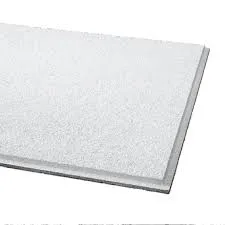- Afrikaans
- Albanian
- Amharic
- Arabic
- Armenian
- Azerbaijani
- Basque
- Belarusian
- Bengali
- Bosnian
- Bulgarian
- Catalan
- Cebuano
- Corsican
- Croatian
- Czech
- Danish
- Dutch
- English
- Esperanto
- Estonian
- French
- German
- Greek
- Hindi
- Indonesian
- irish
- Italian
- Japanese
- Korean
- Lao
- Malay
- Myanmar
- Norwegian
- Norwegian
- Polish
- Portuguese
- Romanian
- Russian
- Serbian
- Spanish
- Swedish
- Thai
- Turkish
- Ukrainian
- Uzbek
- Vietnamese
ное. . 22, 2024 19:42 Back to list
mineral fiber ceiling board specification
Understanding Mineral Fiber Ceiling Board Specifications
Mineral fiber ceiling boards have long been a popular choice in the construction and design industry due to their numerous benefits and versatile applications. Often utilized in commercial, industrial, and residential spaces, these boards provide effective sound absorption, thermal insulation, and aesthetic appeal. Understanding the specifications of mineral fiber ceiling boards is essential for architects, builders, and designers to ensure they select the correct materials for their projects.
Composition and Characteristics
Mineral fiber ceiling boards are primarily composed of natural and synthetic fibers, including mineral wool, fiberglass, and sometimes additional materials to enhance performance characteristics. The composition plays a significant role in determining the board’s properties, such as density, thickness, and fire resistance.
Typically, these boards are produced in various densities, ranging from lightweight to heavy-duty options. The density impacts sound attenuation and thermal performance; heavier boards generally provide better sound insulation and are more resistant to wear and tear. Standard thicknesses for mineral fiber ceiling boards range from 0.5 inches to 1 inch, allowing for flexibility in design while ensuring adequate insulation.
Acoustic Performance
One of the most notable features of mineral fiber ceiling boards is their exceptional acoustic performance. The boards are designed to absorb sound frequencies effectively, making them ideal for environments where noise reduction is paramount. The Noise Reduction Coefficient (NRC) is a critical specification to consider, typically ranging from 0.60 to 0.90 for mineral fiber ceilings. An NRC value close to 1.0 indicates excellent sound absorption capabilities, essential in spaces like auditoriums, offices, and schools.
Fire Resistance
Another vital specification of mineral fiber ceiling boards is their fire resistance. Many products are manufactured to meet stringent fire safety standards, with ratings such as Class A or Class 1 being common. These ratings indicate the board's ability to resist flame spread and smoke development. It is crucial for projects in schools, hospitals, and commercial buildings to utilize materials that not only comply with local fire codes but also offer peace of mind for occupant safety.
mineral fiber ceiling board specification

Thermal Insulation
In addition to sound and fire performance, mineral fiber ceiling boards provide thermal insulation benefits. They can help reduce heating and cooling costs by improving energy efficiency in buildings. The thermal resistance, indicated by the R-value, is an essential aspect of the board’s specification. A higher R-value signifies better insulating properties, which can significantly contribute to reducing energy consumption in commercial and residential buildings.
Aesthetic Appeal
Aesthetically, mineral fiber ceiling boards are available in various designs, textures, and finishes, allowing for creative flexibility in interior design. From smooth profiles to patterned surfaces, these boards can complement a wide range of decor styles. Additionally, many mineral fiber boards can be painted or coated to meet specific design needs, providing even more options for customization.
Installation and Maintenance
The installation of mineral fiber ceiling boards is relatively straightforward, typically involving a grid system that allows for easy access to ductwork and electrical systems above the ceiling. Maintenance is generally low, although periodic cleaning may be necessary to maintain their appearance and performance. Many boards are designed to be resistant to moisture and mold, which further enhances their longevity and suitability for various environments.
Conclusion
In summary, mineral fiber ceiling boards offer an impressive combination of acoustic performance, fire resistance, thermal insulation, and aesthetic versatility. Understanding the specifications of these boards is crucial for making informed choices in building design and renovation projects. When equipped with this knowledge, architects, builders, and designers can select the right products to enhance the functionality and beauty of their spaces while ensuring compliance with safety and performance standards. Whether for a corporate office, a school, or a healthcare facility, mineral fiber ceiling boards remain a trusted and effective choice in the modern construction arsenal.
-
Transform Interiors with PVC Gypsum Ceiling: A Stylish, Durable, and Moisture-Resistant SolutionNewsMay.19,2025
-
The Smart Interior Upgrade: Discover the Durability and Versatility of Gypsum Ceiling Access Panel SolutionsNewsMay.19,2025
-
The Smart Choice for Interior Design: Discover the Value of PVC Gypsum Ceiling SolutionsNewsMay.19,2025
-
Mineral Fiber Ceiling Tiles: The Smart Blend of Performance and AestheticsNewsMay.19,2025
-
Mineral Fiber Ceiling Tiles: The Superior Choice Over Gypsum for Sound and Fire SafetyNewsMay.19,2025
-
Mineral Fiber Ceiling Tiles: Eco-Friendly Strength and Style for Every CeilingNewsMay.19,2025







